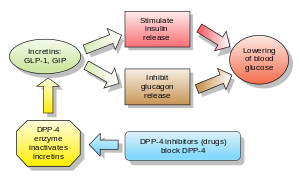Peptide analogs
Incretin mimetics
Incretins are insulin secretagogues. The two main candidate molecules that fulfill criteria for being an incretin are Glucagon-like peptide-1 (GLP-1) and Gastric inhibitory peptide (aka glucose-dependent Insulinotropic peptide or GIP). Both GLP-1 and GIP are rapidly inactivated by the enzyme dipeptidyl peptidase-4 (DPP-4).
Glucagon-like peptide (GLP) analogs and agonists
GLP agonists bind to a membrane GLP receptor.[2] As a consequence of this, insulin release from the pancreatic beta cells is increased. Endogenous GLP has a half life of only a few minutes; thus an analogue of GLP would not be practical.
- Exenatide (also Exendin-4, marketed as Byetta) is the first GLP-1 agonist approved for the treatment of type 2 diabetes. Exenatide is not an analogue of GLP, but rather a GLP agonist.[20][21] Exenatide has only 53% homology with GLP, which increases its resistance to degradation by DPP-4 and extends its half-life.[22] Typical reductions in A1C values are 0.5-1.0%.
- Liraglutide, a once daily human analogue (97% homology), is being developed by Novo Nordisk under the brand name Victoza. The product was approved by the European Medicines Agency (EMEA) on July 3, 2009, and by the U.S. Food and Drug Administration (FDA) on January 25, 2010.[23][24][25][26][27][28]
- Taspoglutide is presently in Phase III Clinical Trials with Hoffman-La Roche.
These agents may also cause a decrease in gastric motility, responsible for the common side effect of nausea, and is probably the mechanism by which weight loss occurs.
Gastric inhibitory peptide (GIP) analogs
- None are FDA approved
DPP-4 inhibitors
Dipeptidyl peptidase-4 (DPP-4) inhibitors increase blood concentration of the incretin GLP-1 (glucagon-like peptide-1) by inhibiting its degradation by dipeptidyl peptidase-4 (DPP-4).
Typical reductions in A1C values are 0.5-1.0%.
Examples are:
- vildagliptin (Galvus) EU Approved 2008.
- sitagliptin (Januvia) FDA approved Oct 2006.
- saxagliptin (Onglyza) FDA Approved July 2009.
Amylin analogues
Amylin agonist analogues slow gastric emptying and suppress glucagon. They have all the incretins actions except stimulation of insulin secretion. As of 2007[update], pramlintide is the only clinically available amylin analogue. Like insulin, it is administered by subcutaneous injection. The most frequent and severe adverse effect of pramlintide is nausea, which occurs mostly at the beginning of treatment and gradually reduces. Typical reductions in A1C values are 0.5-1.0%.

No comments:
Post a Comment
Note: Only a member of this blog may post a comment.